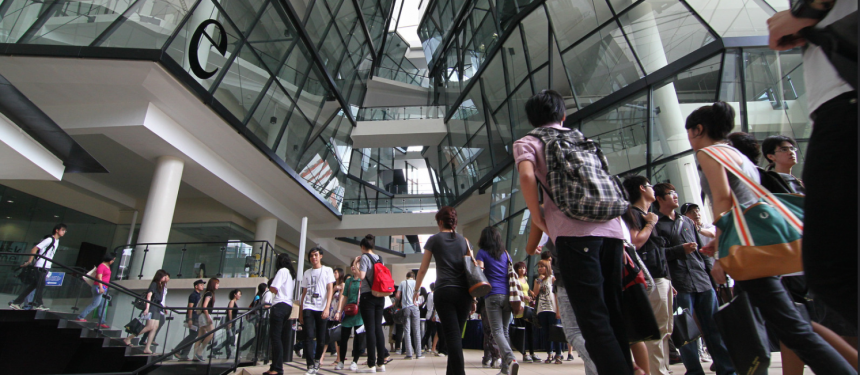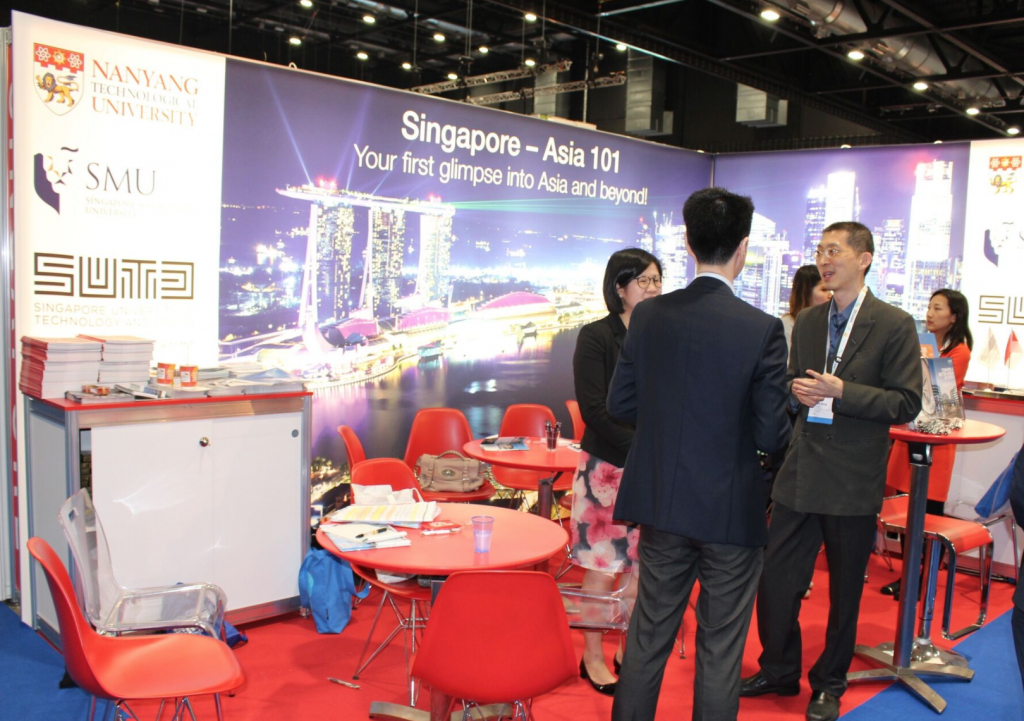Conversations in or about Singapore invariably turn towards notions of success. How the country turned around its economic and political fortunes under Lee Kuan Yew; how a precocious Joseph Schooling overcame his mentor Michael Phelps in the Olympic butterfly final; and how schools in Singapore produce students who know what it takes to make the honour roll.
News and business analysis for Professionals in International Education
Have some pie!
Singapore’s public and private providers strive to stay on top
 LASALLE College of the Arts is one of the private education institutions determined to rival public sector education provision with targeted expert provision. Photo: LaSalle
LASALLE College of the Arts is one of the private education institutions determined to rival public sector education provision with targeted expert provision. Photo: LaSalle This success extends to its position as an education hub, although competition is rising in the east. “I think Singapore still has a lot to offer as an education destination,” says Shabir Aslam, director of the British Council in Singapore. “There have been improvements in infrastructure, in government support for educational excellence at all levels and the two main public universities rank highly in the world university rankings.”
National University of Singapore is ranked number one in Asia and Nanyang Technological University is regularly in the top five. Aslam continues: “This, alongside an educational environment that is welcoming and open to partnership and collaboration, has helped to promote Singapore as one of, if not the most, sought after educational destinations in Asia.”
International intake
Gauging the exact number of international students in Singapore is like trying to find a piece of chewing gum on the MRT subway network. Parliamentary replies from 2015 at least fill in some of the gaps. According to one, “The proportion of international students varies by faculty, ranging from around 1% in medicine and law, courses highly popular with Singaporeans, to 27% in science and engineering.”
That means just over one-third of the broader private sector student intake in Singapore is international
While common estimates put the number of international students in public universities at around 15%, the picture is clearer when examining the private education sector in Singapore. Its regulatory body, the Council for Private Education, states that approximately 77,000 local and 29,000 international students are enrolled in private tertiary colleges, with the most popular offering UK university qualifications via partner institutions.
That means just over one-third of the broader private sector student intake in Singapore is international. Many hail from mainland China, followed by ethnic Chinese from Malaysia, Indonesia and Vietnam, others from those countries and a steady intake of Indians.
It seems the old colonial tie is hard to break too. There are 120 private colleges providing UK qualifications in Singapore, including LaSalle College of Arts (pictured), which delivers its degrees in partnership with Goldsmiths, University of London. Kaplan’s Higher Education Academy runs a Singapore campus that teaches thousands of students degree programmes offered by UK and Australian university partners.

Singapore represents itself at global education fairs as a doorway into Asia
However, Singapore does face mounting competition. “The private education sector in Singapore is definitely entering a new phase in its evolution,” says Aslam, “and the recruitment strategies now have to reflect the new reality. International student numbers are not the guarantee they might once have been, and increased competition from China in particular will make it more difficult for some of these private education institutes in Singapore to continue to compete.”
Public v private tensions
The private education sector also faces competition from its public sector: the stellar reputation of public universities in Singapore, where more than 50% of students gain significant international experience during their courses, has been reinforced in recent surveys conducted by the Singapore Institute of Management. In results published in the gently pro-government Straits Times, significant gaps in job and salary outcomes were revealed to exist between graduates of three of Singapore’s six public universities – National University of Singapore, Nanyang Technical University and Singapore Management University – when compared with students with degrees from a variety of private colleges.
While some critics suggest the spread of private colleges surveyed was an inadequate sample, the real message is perhaps that private colleges need to ensure employability is high up their list of outcomes. Initiatives such as ‘Skills Future Singapore’ (aiming to tackle employment issues borne out of an overqualified workforce) also signal the future direction of education policy.
“It has learned fast how to receive international students and how to take care of them properly”
One marketing executive from a high profile Australian partner college in the country believes the education landscape has changed because of “anti-foreign” worker sentiment. “The private education sector takes a beating because we are perceived to be hogging up placements for the government intake for local students,” they comment. “The government wants to see jobs [created] here in Singapore.”
The need to address this underlying tension between the role of private colleges and the demands of the 21st century economy is not lost on Mei Mei Lim, director of Singapore Institute of Management and a volunteer at the Singapore Association of Private Educators. “Private colleges are struggling to compete,” she says. “So we encourage our members [of SAPE] to really transform the way they run their schools to focus on quality teaching, all aspects of student life, improving online learning, leveraging technology to bring the intellectual property outside Singapore. In short, private institutions really need their students to be work-ready.”
Aslam from the British Council concurs. “Work-ready, competency based modules and programmes might be the way forward for some within the private sector. The trend may be that we see a re-alignment of priorities both in the public and private sector educational institutes with a move towards more vocational skills.”
Living and working in Singapore
The relatively high cost of living – and a scarcity of supervised student housing – is a further source of difficulty for international students in Singapore, particularly given the restrictions placed on foreigners to find legal part-time work. Only international students with an official ‘Student Pass’ are able to work, and only if they are enrolled at one of the six public universities.
Despite these concerns, Singapore remains a popular choice for international students, insists Ajay Sukhwani from Mumbai-based Edwise International, which this year celebrated its 25th birthday as a recruitment agency. Each year, Edwise sends to Singapore roughly 200 Indian students – mostly from Tamil Nadu to connect with the diaspora – where about 70% of those study business management courses.
While Sukhwani is sometimes daunted by the difficulty in securing suitable accommodation for his students – most private colleges are unable to provide any – he is positive about the overall student experience.
“Singapore has come a long way in this respect,” he says. “It has learned fast how to receive international students and how to take care of them properly.”
High school sector
Singapore’s high school system is regarded as one of the best in the world. Yet even within the country, where the public education system regularly places its bilingual, ambitious students among the brightest in the world, the lure of international schools is proving irresistible for parents and businesses alike.
Until recently, Singapore nationals were forbidden from attending private international schools after early childhood. Should a parent hold a foreign passport, or a child be deemed to have been raised for a significant period abroad, then the Ministry of Education would consider their application (on a case-by-case basis), but for everyone else, the public education system served your needs.
Three land parcels were opened up last year to prospective education brands looking to build a shiny campus
But that has changed and in a bold statement to the international school market, three land parcels were opened up last year to prospective education brands looking to build a shiny campus. It’s not clear yet whether the winning applicants are new or current players in the market; but either way, the demand still clearly exists for high quality international education at secondary level.
The exclusive international schools include the so-called ‘top tier’ of three: United World College, Tanglin and SAC. Next come the highly reputable ‘hybrids’ like Hwachang International, St Joseph’s College and Anglo-Chinese School International, which are allowed to enrol at least 50% local Singaporeans. In the words of one commentator, “they do the IB but sing the national anthem”.
This leaves the remaining 20 or so private secondary colleges to fight it out for the remains of the ‘international’ pool, a mixture of handpicked Chinese and Vietnamese star pupils on scholarships, rich kids from other Asian countries whose families can afford the fees, and your typical ‘expat’ children whose parents work for a global firm.
Whether new high-flying arrivals such as GEMS World Academy and Nexus can achieve their lofty admissions targets remains to be seen and will be closely watched by Tiger Mums and Dads in the Lion City. Like a real estate agent circling enough square footage for a soccer pitch and a recital hall, watch this space.
- This is an abridged version of an article from the 12th edition of The PIE Review.
Still looking? Find by category:


